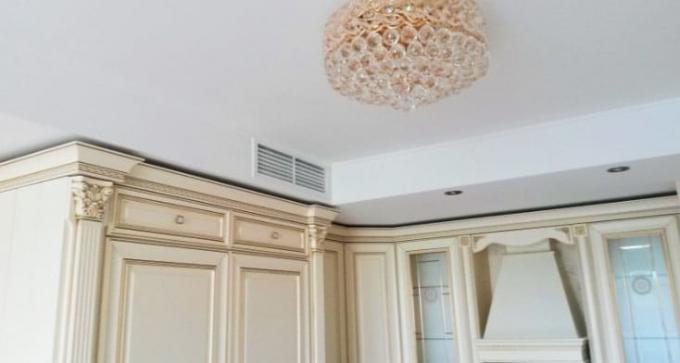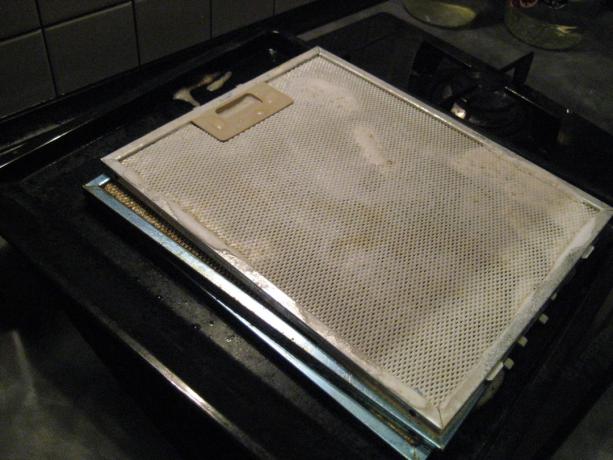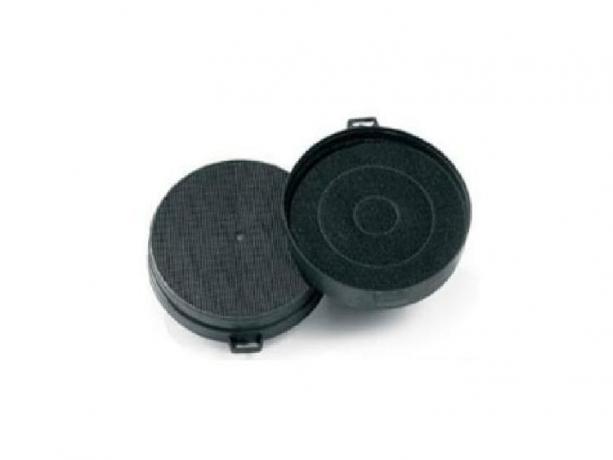Content
-
1 Evacuation or recirculation, what to choose
- 1.1 Evacuation hood: pros and cons
- 1.2 Recirculation hood: pros and cons
-
2 Some myths about filters
- 2.1 Myth 1: an evacuation hood removes all odors, but the filter does not.
- 2.2 Myth 2: it is cheaper to connect the hood to the ventilation once than to change filters
- 2.3 Myth 3: you will have to search and purchase filters of only the same brand as your hood.
- 2.4 Myth 4: filters "eat up" the extraction performance and reduce the throughput of the machine
- 3 Installation and assembly work
- 4 Conclusion
Many housewives appreciated the advantages of a kitchen equipped with a high-quality hood. This is clean air, and the absence of soot on furniture and walls, and just a clean and tidy kitchen as a whole. But there are different hoods: evacuation, kitchen recirculation-type coal hoods, with a grease filter, without it, etc.
Today we will talk about a cooker hood with a charcoal filter: there are a lot of myths and prejudices that must be dispelled or confirmed in order to draw the correct conclusion about these devices.

A kitchen without a hood is like a wedding without a bride.
Evacuation or recirculation, what to choose
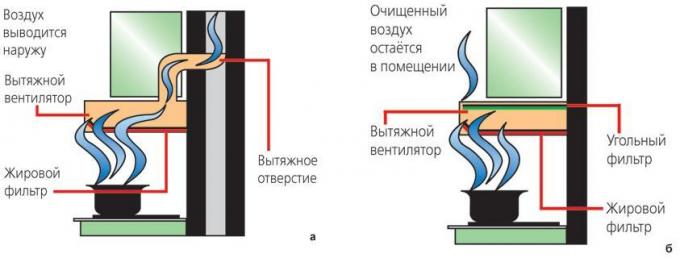
In the diagram: a - evacuation hood; b - recirculation hood.
There are two main types of cooker hoods.
- First type evacuates air outside the premises through the air removal and ventilation system. In this case, the removed air should be replaced by the same volume of clean air through an open window or door. Otherwise, you will have to take care of an additional oxygen supply channel so that a rarefied mountain atmosphere does not arise (this article is not for climbers).
- Second type works on the principle of circulation. The sucked in air passes through a filter system that captures odors and grease, and then returns to the room. Thus, the natural ventilation of the kitchen is not disturbed. Moreover, there is no need to build a duct system and break through additional ventilation windows. Also, no major re-equipment of kitchen furniture is required.
Evacuation hood: pros and cons

The exhaust window is not always located above the stove.
Let's list the advantages of evacuation systems:
- The performance of such a hood is certainly higher;
- No need to change filters;
- Soot and smoke are simply removed from the kitchen, and clean air from the street is supplied to replace them.
Now the disadvantages:
- Requires connection to a ventilation duct;
- In order not to disturb natural ventilation, you need a check valve or "cracker";
- A source of fresh air is needed, otherwise reverse draft from the ventilation ducts of the bathrooms may occur, which is fraught with unpleasant odors;
- A powerful hood can "pump" your neighbors with soot, because the channel is common;
- Installation of an air duct is required, which may not fit into the interior of your kitchen, and masking it can be expensive;
- Air ducts often begin to "sing": to make a hum, roar or other sounds;
- Warm air is pumped out of the room, replacing it with cold outdoor air, which is very unprofitable in winter, given the cost of heating; in the summertime, the same happens with the cooled air, over which the air conditioner tried so hard.
Advice! Evacuation hoods justify their cost and the cost of connecting in professional kitchens in cafes and restaurants. For an ordinary apartment, a simple hood with a filter is enough.
Recirculation hood: pros and cons

The charcoal hood for the kitchen is easier to build in and looks neater.
Now let's list the advantages of recirculation systems:
- Does not require complicated and expensive assembly and installation work;
- Do not disturb the natural ventilation of the kitchen;
- Do not require additional ventilation ducts and windows;
- Does not disturb the kitchen interior;
- Do not cause backdraft of canals in bathrooms and do not smoke neighbors;
- They quite cope with the air purification of an ordinary kitchen in a city apartment;
- They do not violate the microclimate of the room.
Disadvantages:
- The need to change filters;
- Less productivity;
- Filters are not 100% clean;
- A heavily clogged filter increases the load on the engine and can damage the engine.
Read also the article "The quietest hoods for the kitchen: how important it is."
Some myths about filters

A properly selected hood can become not only a useful unit, but also a stylish accessory.
Myth 1: an evacuation hood removes all odors, but the filter does not.
- Firstly, no extractor hood can remove 100% of odors from the kitchen. In the exhaust mode, the air is cleaned somewhat more efficiently, but it still mixes with the outside air supplied to it for replacement. As a result, the smell is diluted, but remains. Moreover, the freshness and smell of street air in big cities is questionable.
- Secondly, it is not so easy to set up the operation of an exhaust hood. The fact is that the ventilation ducts in our houses do not meet the standards for which imported hoods are created. Moreover, they are often littered or completely clogged. Therefore, powerful systems that are so praised are often simply not able to work in the desired mode.
- Thirdly, the main task of the hood is to clean the air from grease and soot, which are harmful to humans and leave plaque on furniture and walls. The grease filters of recirculation systems cope with this task quite satisfactorily.
- Fourth, most evacuation hoods also have filters to protect motors and air ducts. And these filters also get clogged and need to be replaced.
Conclusion: the complete removal of odors from the kitchen is impossible in principle, regardless of the type of hood. Both models cope with the main task - cleaning the air from grease and soot.

Hoods can have a wide variety of designs.
Myth 2: it is cheaper to connect the hood to the ventilation once than to change filters
- Firstly, as already mentioned, the manufacturers of hoods operating on a drain recommend the use of filters to protect the engine and other internal systems of the device.
- Secondly, the cost of the cheapest kit for connecting to ventilation (corrugated aluminum duct, adapters, clamps, sealant, polyurethane foam, etc.) will cost 1000 rubles.
If you wish to hide the duct, add 1000 more. If you want the air duct not to emit a hum, you will have to fork out for a PVC pipe - another 500 rubles. Thus, the materials will cost 2500 rubles.
Work on connecting to the ventilation duct plus permission - up to 4000 rubles. Add additional ventilation here, and you get an amount reaching 8-10 thousand.
The average price of a carbon filter is 400 rubles. It must be changed 4 times a year. This means that you will provide yourself at least 5 years of filter replacement only on savings due to connection. And we still do not take such cases when you have to change furniture and wall decoration.

Aluminum filters can simply be washed once a month with detergent.
- Thirdly, as seen in the photo, the aluminum filter can be washed with hot water and detergent like a regular plate and used like new. But it is he who performs the main function - cleaning from fat.
Conclusion: it is more economical to purchase and operate a hood with a filter.
Myth 3: you will have to search and purchase filters of only the same brand as your hood.
This is not entirely true. Embedded technology manufacturers specialize in technology, and the production of consumables is trusted proven companies with a good reputation, which specialize in this particular product, in particular on filters.
Moreover, manufacturers of consumables make filters not the worst, but more often even the best. quality, while not making a mark-up for a big name and brand, as well-known manufacturers do technology.

Hoods can have the most unexpected additional functions.
Myth 4: filters "eat up" the extraction performance and reduce the throughput of the machine
Some "researchers" even quote figures: in the recirculation mode, the hood loses 30% of its power compared to the exhaust mode. This is the real heresy, because no one has carried out any research and measurements with comparative characteristics.
It should also be reminded to such would-be researchers that modern filters of leading brands are so thin that even in the most clogged state they simply cannot physically are able to reduce the air flow, and even more so the power (it is not clear how this physical quantity even got into this context) not only by a third, but even by a fifth part.
We draw an obvious conclusion: the numbers are taken from the ceiling, the statement is unfounded.
Let's go further: first of all, the aluminum filter gets clogged, since it is he who catches grease and soot. But it is enough to rinse this filter once a month in the dishwasher or in the sink - and your hood works at full again.
Finally, if we are already talking about the decrease in productivity and throughput of the hood, let's remember about the duct and bends, each turn of which reduces performance by 10%, and this fact.
Next, let's remember the good old Soviet ventilation, and it turns out that coal cooker hoods are the most productive hoods in the world! This is a joke, but in every joke ...
Conclusion: you should not believe myths and unfounded unsubstantiated statements. The power and performance of the hood is indicated in its technical data sheet, taking into account the filter.
Choosing a filter for a kitchen hood - see here.
Installation and assembly work

Even a woman can install the hood.
Another indisputable advantage of recirculation hoods is the ability to install them by hand without any problems.
To do this, you need a minimum set of tools:
- Electric hammer drill with a drill for concrete;
- A hammer;
- Screwdriver;
- Screwdriver;
- Level;
- A set of mounting dowels.
The distance from the hood to the hob must be at least 80 centimeters. The width of the hood should not be less than the width of the plate, it is better to exceed it a little.
Mark and drill the first hole in the wall at the desired height. Drive a dowel into it. Next, hang the hood on one anchor screw, and ask the assistant to set the device as even as possible. You can use a level for this.
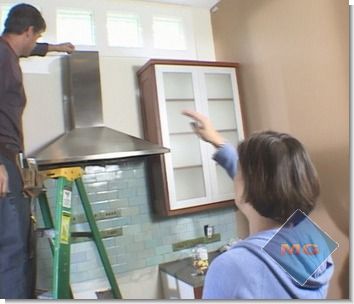
Correct the position of the hood at a distance before it is completely secured.
Next, mark the remaining points through the mounting holes, in which you then drill the holes by removing the hood. Drive dowels into all holes. Hang the device and use the anchor screws firmly enough to fasten it to the wall.
This is the most general instruction, which is sufficient for installing the hood. For greater clarity, we bring to your attention a video that will help you get acquainted in more detail with the process of installing a coal hood in your kitchen.
Installing the hood in the kitchen according to the rules - see here.
Conclusion
In an ordinary city apartment in which an ordinary city family lives, it is quite enough to install a recirculation-type kitchen hood.
Replacing the charcoal filter every three months and washing the aluminum filter once a month is not a problem at all, but here is clean kitchen furniture, no soot and grease, fresh air and a good mood for you provided.
